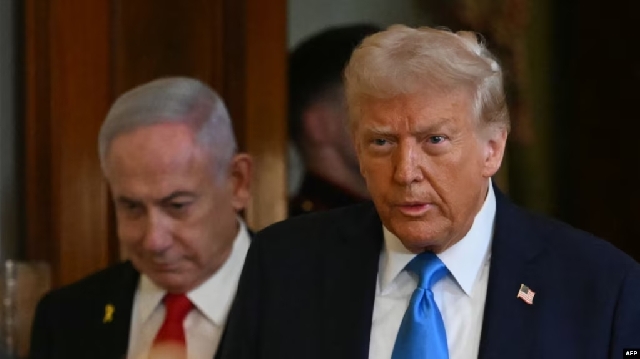Trump says U.S. will take ownership of Gaza
 US President Donald Trump and Israel's Prime Minister Benjamin Netanyahu arrive to hold a press conference in the East Room of the White House in Washington on Feb. 4, 2025
US President Donald Trump and Israel's Prime Minister Benjamin Netanyahu arrive to hold a press conference in the East Room of the White House in Washington on Feb. 4, 2025
U.S. President Donald Trump said he wants the United States to take ownership of Gaza, moving beyond his earlier statements of forcing Palestinians in the war-torn enclave to relocate to neighboring Jordan and Egypt.
“The U.S. will take over the Gaza Strip, and we will do a job with it, too,” he said during a joint press conference with Israeli Prime Minister Benjamin Netanyahu at the White House Tuesday evening.
In recent days hundreds of thousands of Palestinians in the southern parts of Gaza have marched north toward their homes after Israel allowed people to return as part of the ceasefire for a hostage release deal with Hamas.
Trump said he wants to develop the area into what he calls “the Riviera of the Middle East.”
“Everybody I've spoken to loves the idea of the United States owning that piece of land, developing and creating thousands of jobs with something that will be magnificent, in a really magnificent area,” he said.
Netanyahu said one of his war goals is to ensure that Hamas never poses a threat to Israel again. But Trump, Netanyahu said, is “taking it to a much higher level.”
“I think it’s something that could change history, and it’s worthwhile really pursuing this avenue,” he added.
Trump did not share details on how he plans to exert control over the area ravaged by 15 months of war, but he did not rule out sending U.S. troops.
“If it’s necessary, we’ll do that. We’re going to take over that piece, and we’re going to develop it,” he said.
Trump’s comments mark a remarkable shift from his criticism of America’s involvement in Middle East conflicts. He sees a “long-term ownership position,” for the U.S. that would bring “great stability to that part of the Middle East, and maybe the entire Middle East.”
“This was not a decision made lightly,” he said.
However, any discussion of relocation will certainly be met with resistance from Palestinians. Hundreds of thousands were driven from their homes in what is now called Israel: in the 1948 war surrounding Israel’s creation and during Israel’s 1967 seizure of the West Bank and Gaza Strip.
There are currently 2.1 million people in Gaza, according to the United Nations.
The Palestinian Authority said Wednesday that Trump’s proposal would be “a serious violation of international law.”
Egypt’s Foreign Ministry also expressed opposition, highlighting the need to carry out post-war reconstruction “without moving the Palestinians out of the Gaza Strip.”
China, Australia, Turkey and France all backed the need to pursue a two-state solution for peace in the region.
It’s unclear how occupying Gaza would fit into Trump’s own stated goal of expanding the Abraham Accords to include Riyadh. He brokered the deal that normalized ties between Israel and Arab countries in 2020.
Saudi Arabia quickly reacted to Trump’s Gaza comments by saying it will not establish diplomatic relations with Israel without the creation of a Palestinian state, and that its position is nonnegotiable.
“The kingdom of Saudi Arabia also stresses what it had previously announced regarding its absolute rejection of infringement on the legitimate rights of the Palestinian people, whether through Israeli settlement policies, annexation of Palestinian lands or efforts to displace the Palestinian people from their land,” the Saudi Foreign Ministry said in a statement.
Trump’s statement on Gaza is his latest signaling of expansionist ambitions, following his statements to acquire Greenland from Denmark, taking over the Panama Canal, and absorbing Canada.
Ceasefire renegotiation
Speaking to reporters at the White House earlier Tuesday, U.S. Middle East envoy Steve Witkoff said the administration has begun negotiations toward Phase 2 of the three-phase ceasefire-for-hostage-release deal, which includes the release of all remaining hostages held in Gaza, a permanent halt in fighting and Israel’s withdrawal from the territory.
Hamas, a U.S.-designated terror group, has released 18 hostages so far, while Israel has freed hundreds of Palestinian prisoners.
Witkoff suggested that the administration is considering renegotiating parts of the agreement that took effect on Jan. 19, the day before Trump was inaugurated.
“Part of the problem is that it wasn’t such a wonderful agreement that was first signed. That was not dictated by the Trump administration. We had nothing to do with it,” he said. “Now we’re working within that rubric, and we’re figuring things out.”
He doubled down on Trump’s suggestion to remove Gazans, saying that the five-year reconstruction plan for Gaza as outlined in phase three is “physically impossible.”
Trump’s insistence on relocating Gazans could signal a desire to renegotiate the ceasefire deal, particularly the second phase, said Ahmed Fouad Alkhatib, a senior fellow at the Atlantic Council.
“The goal might be to force Hamas into choosing between relinquishing control of Gaza or leaving the Strip if it wants an Israeli withdrawal or reconstruction, or risk the entirety of the population facing forcible removal, though how that would be carried out is unknown,” he told VOA.
Also Tuesday, Trump ended support for the UN agency that helps Palestinian refugees and withdrew the U.S. from what he calls the antisemitic UN Human Rights Council.
Iran nuclear
Shortly before his meeting with Netanyahu, Trump directed his aides to restore his "maximum pressure" campaign on Iran to prevent it from getting a nuclear weapon and to drive down its oil exports to zero.
“I'm unhappy to do it, but I really have not so much choice, because we have to be strong and firm, and I hope that it's not going to have to be used in any great measure at all,” he said. “It's very simple. Iran cannot have a nuclear weapon.”
As of September 2024, U.S. intelligence concluded in a report that Iran is not building a nuclear weapon. However, Iran has “undertaken activities that better position it to produce one, if it so chooses,” the report said.
In November, the Justice Department under the Biden administration announced that an Iranian plot to kill Trump before the presidential election had been thwarted. Trump said he has directed his aides to “obliterate” Tehran if the Iranian regime moves to assassinate him.
“If they did that they would be obliterated,” Trump said. “I’ve left instructions if they do it, they get obliterated, there won’t be anything left.”
Pressure on Netanyahu
Trump’s meeting with Netanyahu comes as the Israeli leader faces pressure from his right-wing coalition to end the ceasefire.
Both Trump and Netanyahu share the goal of ending Hamas’ rule in Gaza and return the remaining Israeli hostages, said Jonathan Rynhold, head of the Department of Political Studies at Bar Ilan University. However, the two men place different priorities on different aspects of the goal.
For Netanyahu, the priority is to ensure Hamas has no political future, Rynhold told VOA, while for Trump it’s to maintain the ceasefire “so that he can move to an Israeli-Saudi Arabian normalization agreement.”
U.S. administrations under Presidents George W. Bush to Joe Biden have stated their support for Palestinian statehood under the two-state solution. In 2020 during his first term, Trump announced his Middle East peace plan that would deny Palestinians having their own state.
Trump was non-committal when asked Tuesday whether he supports the two-state solution. His plan on Gaza “doesn't mean anything about a two-state or one-state or any other state,” he said.
The war in Gaza began with the Oct. 7, 2023, Hamas attack that killed 1,200 people in Israel and took about 250 people hostage. Israel’s counteroffensive has killed more than 47,500 Palestinians, more than half of them women and children. Israel’s military says the death toll includes 17,000 Hamas militants.
Trending World

Zelensky's conciliatory letter to Trump suggests he's out of options
19:05
Trump declares ‘America is back,’ defends tariffs, other policies in address to Congress
18:22
Pope resting after acute breathing crises forced him to resume noninvasive ventilation
02:25
Nigeria, China crack down on Chinese nationals in financial crimes
01:31
China sets 5% economic growth target for 2025
01:26
'Killing machine' is operating nonstop with more people executed in Iran
01:22
UN urges Taliban to end restrictions on girls on International Women’s Day
23:56
Pope Francis responds well to treatment for double pneumonia
23:54
Trump confirms direct talks with Hamas
20:29
Iran, Russia, China to hold joint military exercises
23:34



